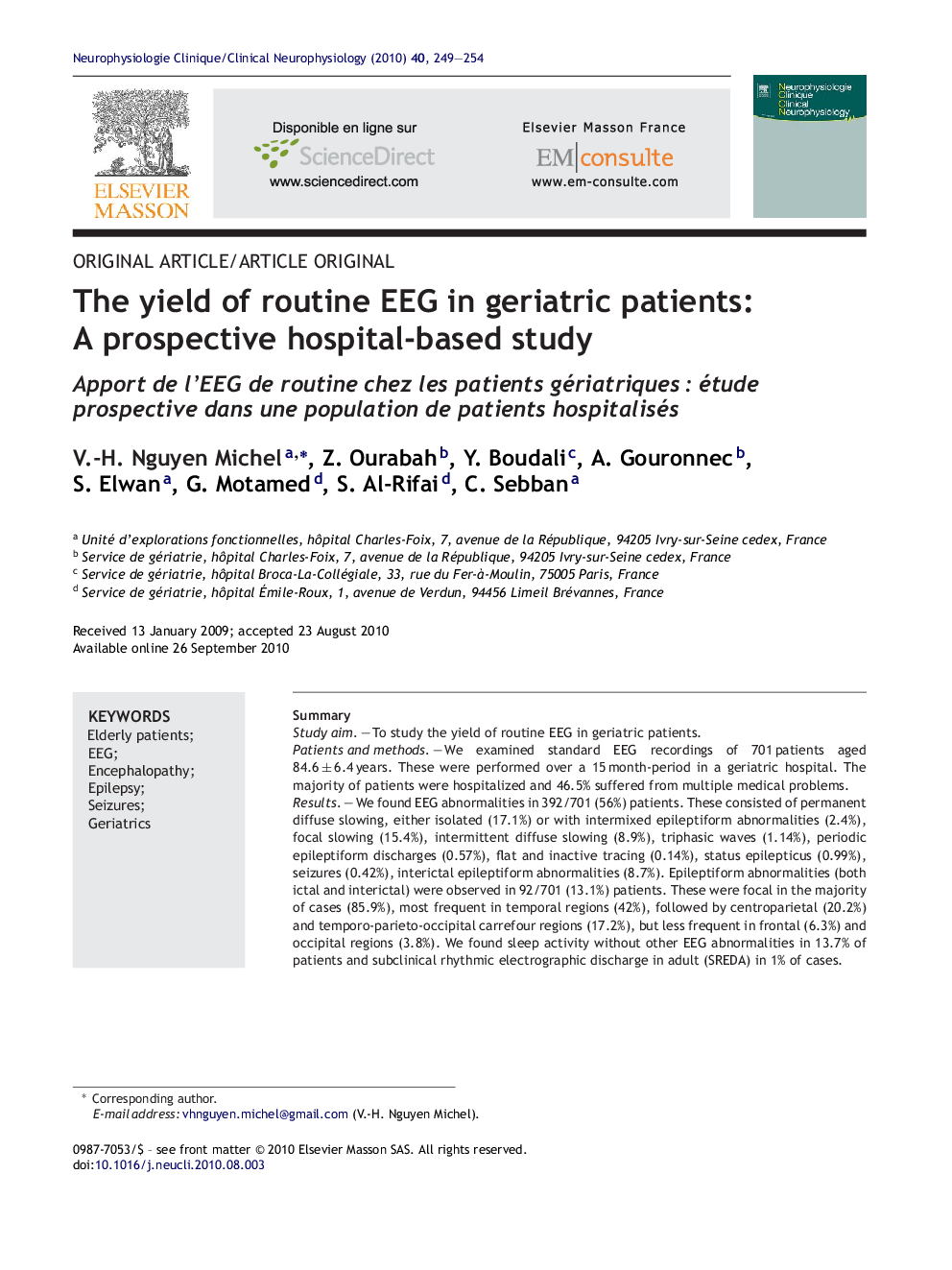| کد مقاله | کد نشریه | سال انتشار | مقاله انگلیسی | نسخه تمام متن |
|---|---|---|---|---|
| 3083020 | 1581110 | 2010 | 6 صفحه PDF | دانلود رایگان |

SummaryStudy aimTo study the yield of routine EEG in geriatric patients.Patients and methodsWe examined standard EEG recordings of 701 patients aged 84.6 ± 6.4 years. These were performed over a 15 month-period in a geriatric hospital. The majority of patients were hospitalized and 46.5% suffered from multiple medical problems.ResultsWe found EEG abnormalities in 392/701 (56%) patients. These consisted of permanent diffuse slowing, either isolated (17.1%) or with intermixed epileptiform abnormalities (2.4%), focal slowing (15.4%), intermittent diffuse slowing (8.9%), triphasic waves (1.14%), periodic epileptiform discharges (0.57%), flat and inactive tracing (0.14%), status epilepticus (0.99%), seizures (0.42%), interictal epileptiform abnormalities (8.7%). Epileptiform abnormalities (both ictal and interictal) were observed in 92/701 (13.1%) patients. These were focal in the majority of cases (85.9%), most frequent in temporal regions (42%), followed by centroparietal (20.2%) and temporo-parieto-occipital carrefour regions (17.2%), but less frequent in frontal (6.3%) and occipital regions (3.8%). We found sleep activity without other EEG abnormalities in 13.7% of patients and subclinical rhythmic electrographic discharge in adult (SREDA) in 1% of cases.ConclusionsIn this study, EEG abnormalities were very common, which reflects the high frequency of cerebral dysfunction in geriatric patients. These abnormalities are of various types, often suggestive of different aetiologies, and may be helpful in clinical management.
RésuméAfin d’examiner l’intérêt de l’EEG standard chez les malades gériatriques, nous avons examiné les tracés de 701 patients (âge moyen de 84,6 ans) réalisés sur une période de 15 mois. La majorité des patients étaient hospitalisés avec, pour 46,5 % d’entre eux, une polypathologie.RésultatsNous avons trouvé des anomalies EEG chez 392 patients sur 701 (56 %) consistant en : activité lente diffuse permanente isolée (17,1 %) ou associée à des anomalies épileptiques (2,4 %), anomalies lentes focales (15,4 %), anomalies lentes diffuses intermittentes (8,9 %), ondes triphasiques (1,14 %), décharges périodiques épileptiformes (0,57 %), tracé plat et inactif (0,14 %), état de mal épileptique (0,99 %), crise épileptique (0,42 %), anomalies épileptiques intercritiques (8,7 %). Les anomalies épileptiques (critiques et intercritiques) sont observées chez 92 patients sur 701 (13,1 %). Elles étaient focales dans 85,9 % des cas avec des localisations temporales (42 %) centropariétales (20,2 %), dans le carrefour temporo-pariéto-occipital (17,2 %), frontales (6,3 %) et occipitales (3,8 %). Nous avons observé une activité de sommeil sans autres anomalies EEG dans 13,7 % des cas et des décharges rythmiques infracliniques de l’adulte dans un pourcent des cas.ConclusionsDans cette étude, le taux d’anomalies EEG est élevé témoignant d’une dysfonction cérébrale fréquente chez les patients gériatriques. Ces anomalies, de types variables, peuvent suggérer différentes étiologies et contribuer à l’orientation diagnostique et thérapeutique.
Journal: Neurophysiologie Clinique/Clinical Neurophysiology - Volume 40, Issues 5–6, November–December 2010, Pages 249–254